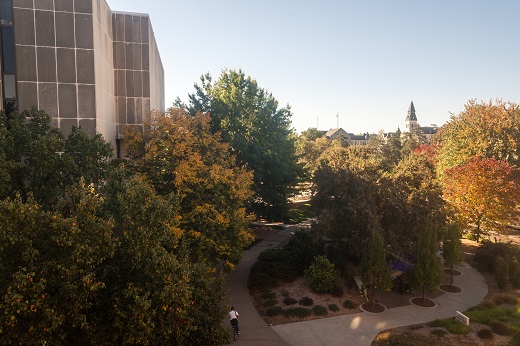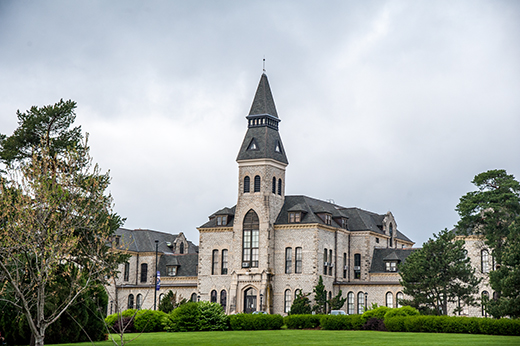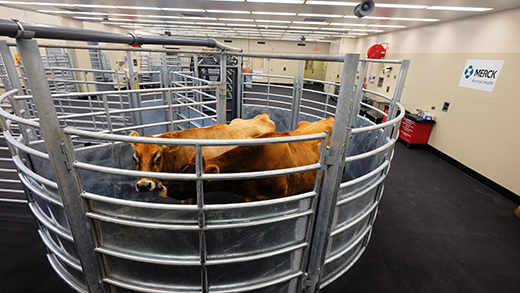10/14/20
K-State Current - October 14, 2020
K-State Current is a weekly news update for the Kansas Board of Regents to apprise the Regents on a few of the many successes and achievements made by K-State faculty, staff and students.
K-State News
Fall 2020 brings university's highest retention, graduation rates
 For fall 2020, freshman-to-sophomore retention is up 1.3% to a record 87.1% at Kansas State University. K-State's four- and six-year graduation rates also set records.
For fall 2020, freshman-to-sophomore retention is up 1.3% to a record 87.1% at Kansas State University. K-State's four- and six-year graduation rates also set records.
Kansas State University's fall 2020 enrollment numbers show strong progress is being made in student success, with records set for student retention and the university's four- and six-year graduation rates. Online program enrollment continues to climb as well.
Fall 2020 enrollment at Kansas State University is mirroring national and state trends related to the COVID-19 pandemic, said Karen Goos, vice provost for enrollment management. The university's overall enrollment is 20,854, down 865 students from a year ago, for a 4% drop. Enrollment on the Manhattan campus is down 6.1% in all students, with the majority of the dip in undergraduate student enrollment, which is down 6.9%.
Goos said that despite the drop, the university's strategic enrollment management efforts are showing progress in the university's recruitment efforts with a 7.5% increase in applications before the pandemic.
"Our 4% drop is much lower than expected and we know the next year will bring strong opportunities for growth when our new Missouri Tuition Match Program, providing in-state tuition to qualified Missouri students, takes effect in fall 2021," Goos said. "Our new scholarship plans also are making a difference and helping more students, with more than $46 million awarded to K-State students this academic year."
On the growth side this fall, undergraduate enrollment is up on both the Kansas State University Polytechnic and K-State Olathe campuses. Online program enrollment also jumped by 10.8%.
The most significant growth is in K-State's student retention and graduation rates. Freshman-to-sophomore retention is up 1.3% to a record 87.1%. Moreover, the student retention rate is up 7% since the university put plans in place to reach a 90% retention rate by 2025.
K-State's four-year graduation continues to climb with a 5.4% increase, while the six-year graduation rate is up 2.3% for the year to 67.5%. The six-year rate is up 11% since the university set a goal of hitting 70% by 2025.
"These increases are strong and indicate that our first-year student success programs and overall student-first approaches help keep students at K-State," said Jeannie Brown Leonard, vice provost for student success.
Because of the enrollment dip, overall student credit hours are down 5.1%, with most of the decline in undergraduate credit hours. Increasing though, by 1.3%, are graduate credit hours. K-State conferred its most doctorates ever — 211 — in the 2019-2020 academic year.
Livestock Services' renovations boast increased safety and new technology
 A new bud flow tub is one of many new additions that provide increased safety in the handling and treatment area for Livestock Services at K-State's Veterinary Health Center. Renovations will benefit clients, clinicians and veterinary students.
A new bud flow tub is one of many new additions that provide increased safety in the handling and treatment area for Livestock Services at K-State's Veterinary Health Center. Renovations will benefit clients, clinicians and veterinary students.
The Livestock Services' handling and treatment area in the Kansas State University Veterinary Health Center has recently undergone significant renovations and is now open to patients.
According to Matt Miesner, section head and clinical professor in Livestock Services at the Veterinary Health Center, improvements not only came from a need for structural repair, but also a need to ensure the standards of modern, safe, efficient and low-stress animal handling methods. He said these changes will benefit clients, clinicians and veterinary students.
"We will be able to process more patients more safely and efficiently, and students will have the opportunity to see more cases safely and experience multiple handling methods recommended by leading experts in the cattle industry," Miesner said. "Clients should see an efficient, safe and modern service for their animals."
Upgrades include:
- New drive-thru unloading feature to improve patient drop-off and pickup.
- Holding pens, alleyways, sweep and bud tub handling of cattle to improve output and safer movement of patients.
- A new tilt chute provides increased versatility to examine a variety of large animal patients that present for lameness.
- An upgraded obstetrics handling area will improve services provided for pregnancy-related disorders.
"It is our mission to meet the highest accreditation compliance standards," said Elizabeth Davis, interim director for the Veterinary Health Center. "With this aim in mind, we planned for structural and equipment upgrades to provide optimal patient care and teaching space. We are pleased to have these upgrades complete which will allow us to provide high-quality large animal patient care in a contemporary facility."
The team began brainstorming ideas a few years ago, through careful design they developed plans that would be ideally suited for Veterinary Health Center clientele and their livestock. The project broke ground in February and was finished in just six months. During this time, clients delivered patients to an alternate receiving area.
Miesner said Livestock Services is incredibly grateful to its clients for their patience through the renovation process and looks forward to providing services in the newly renovated facility.
Merck Animal Health and the Veterinary Health Center made the renovations possible.
To schedule an appointment, please call 785-532-5700 or learn more about the livestock services section at vet.k-state.edu/vhc/services/livestock-services
K-State Faculty Highlights
Rice named Educator of the Year by regional group
 Kansas State University soil microbiology professor Chuck Rice has been named Educator of the Year by the Mid America CropLife Association.
Kansas State University soil microbiology professor Chuck Rice has been named Educator of the Year by the Mid America CropLife Association.
Rice, a University Distinguished Professor who holds the Vanier University Professorship at K-State, was recognized for “significant contributions to American agriculture” and “evidence of consistency in educating the public on the value of production agriculture,” according to a news release from MACA.
Rice has worked in K-State’s Department of Agronomy since 1988. He specializes in soil microbiology, carbon cycling and climate change.
In 2007, he received a Nobel Peace Prize for his work with the United Nations Intergovernmental Panel on Climate Change. He is described by colleagues as a relentless advocate for conservation agriculture, and is considered an influential speaker on soil health and conservation practices for production agriculture.
Rice has served on numerous national bodies, including:
- The National Corn Growers Task Force for Greenhouse Gas Emissions and Global Warming.
- The Board on Agriculture and Natural Resources of the U.S. National Academies of Science, Engineering and Medicine, for which he chairs the board.
- The No-Till on the Plains farmer association.
- The Soil Health Partnership, as a technical advisor. The group leads farmer-driven soil research on more than 160 active farms in the United States.
- The USDA Agriculture Air Quality Task Force.
Rice also sits on the advisory panel of several corporate sustainability teams across the industry, and is an active teaching professor. He has advised more than 47 graduate students and 18 post-doctoral students and visiting scientists, and is an author on more than 225 publications.
The Mid America CropLife Association is a non-profit group of manufacturers, distributors/formulators and allied industry of crop protection products in 13 Midwestern states. The group works to conduct research related to improving crop production.
Hight receives award from Society of American Archivists
 Cliff Hight, associate professor and head of the Richard L. D. and Marjorie J. Morse Department of Special Collections at K-State Libraries, was recently recognized at the annual meeting of the Society of American Archivists. Hight and other members of the society's Dictionary Working Group received the SAA Council Exemplary Service Award for publishing the Dictionary of Archives Terminology.
Cliff Hight, associate professor and head of the Richard L. D. and Marjorie J. Morse Department of Special Collections at K-State Libraries, was recently recognized at the annual meeting of the Society of American Archivists. Hight and other members of the society's Dictionary Working Group received the SAA Council Exemplary Service Award for publishing the Dictionary of Archives Terminology.
The Dictionary of Archives Terminology is a comprehensive intellectual resource that provides open access to an authoritative archival lexicon. Learn more about this resource and the award at the society's webpage.
Computer science lab director Arslan Munir funded by NASA for space research
 This graphic, courtesy of NASA, illustrates the spacecraft trajectory optimization research the space agency is seeking from a project involving Kansas State University.
This graphic, courtesy of NASA, illustrates the spacecraft trajectory optimization research the space agency is seeking from a project involving Kansas State University.
Spacecraft trajectory optimization is a critical aspect of space mission analysis. In recent years, NASA has shown increased interest in applying machine-learning algorithms to improve the performance of trajectory optimization solvers in preparation for a human-tended lunar orbiting platform for crews to visit from earth, to transit to and from the lunar surface, and to depart to and return from Mars.
Optimization of trajectories for spacecraft employing solar-electric propulsion requires the solution of a nonlinear, non-convex mathematical programming problem. For assistance in solving this issue, NASA has awarded $750,000 toward a joint project involving researchers at Wichita State University, Kansas State University and the University of Kansas.
 Investigative lead for "Artificial Intelligence-Assisted Spacecraft Trajectory Optimization and Planning" at Kansas State University is Arslan Munir, assistant professor, Michelle Munson-Serban Simu Keystone research faculty scholar and founding director of the Intelligent Systems, Computer Architecture, Analytics and Security Laboratory in the computer science department at the Carl R. Ice College of Engineering.
Investigative lead for "Artificial Intelligence-Assisted Spacecraft Trajectory Optimization and Planning" at Kansas State University is Arslan Munir, assistant professor, Michelle Munson-Serban Simu Keystone research faculty scholar and founding director of the Intelligent Systems, Computer Architecture, Analytics and Security Laboratory in the computer science department at the Carl R. Ice College of Engineering.
This project targets development of a new, machine-learning assisted-optimization tool for on-ground mission design. The automated, fast and robust nature of the proposed methodologies makes the tool suitable for onboard implementation as well.
"The plan is to develop various innovative concepts such as using dynamical coordinates in trajectory optimization, a modified-state observer to estimate unmodeled acceleration and use of an artificial neural network for adaptive tuning of planning variables," Munir said.
The proposed research will directly benefit space mission design by incorporating machine learning to reduce the sub-optimality of trajectories computed in a fast and robust manner and to capture unmodeled space environmental effects.
"Considering the increasing significance of space research in recent years," Munir said, "this project will help enable K-State to make significant contributions to a challenging problem of spacecraft trajectory optimization that is paramount for planetary exploration missions.
"It will also increase the recognition and leadership of Kansas State University in space research and will be a step forward in the direction of attaining both university and College of Engineering 2025 goals."